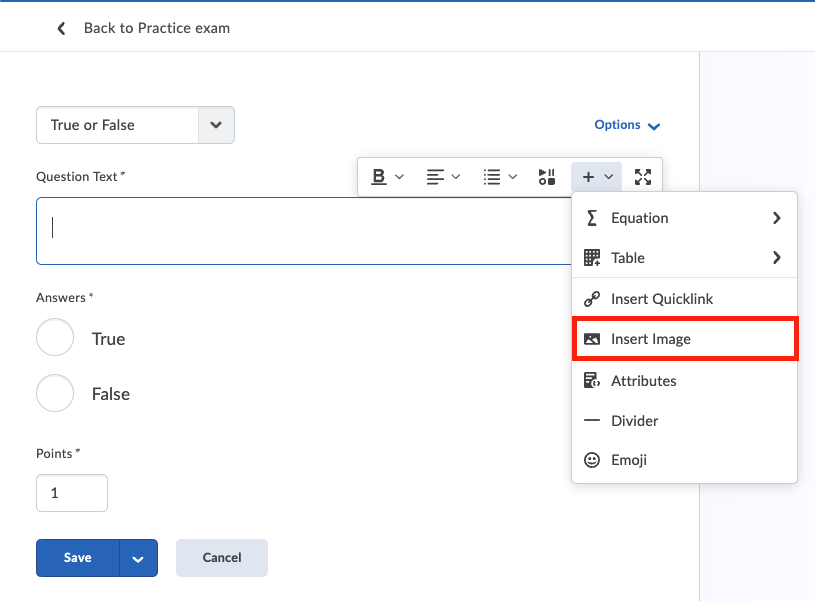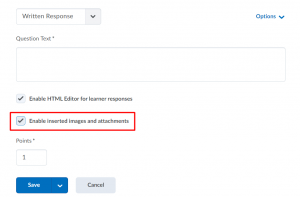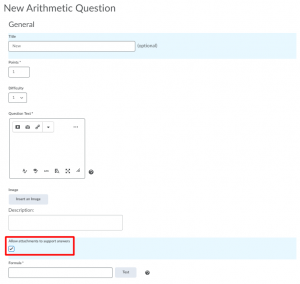On this page you learn how to create Questions in Brightspace and what type of questions there are.
Creating Questions
There are two ways to create questions in Quizzes, Surveys and Self Assessments:
- Add new questions directly
- Build a Question Library (and import them into your Quiz, Survey or Self Assessment).
Tip: The advantage of using the Question Library is that all questions that you create will be saved there and can be reused later in any new Quiz, Survey or Self-Assessment.
- Go to Course Admin
- Click on Quizzes, Surveys or Self-Assessments
- Make sure you created your Quiz, Survey or Self Assessment.
- Click on the Quiz, Survey or Self Assessment to which you wish to add a new question.
- Click on select Add/Edit Questions
If you create a new Self Assessment you first need to save it before you can Add/Edit Questions.
- Optionally add a Section. Sections are folders that help you sort questions from the Question Library.
- Click on Add > Section
- Give the Section a Title
- Optionally Hide Selection Title from learners
- Optionally add a Section Text and Hide the Text from learners
- Optionally check Shuffle questions to randomize the order in which students get the question within the section.
- Click Save
- To add questions you have 2 options:
- Create and add new questions:
- Click on Add > New Question and choose a Question Type.
- Compose the question
- Import existing questions from a Question Library or a CSV file.
While using special characters in your question, make sure to save the file as a CSV UTF-8.
- Create and add new questions:
- Repeat the steps above until you added all Questions and/or Sections.
- Click on Back to [name Quiz, Survey or Self-Assessment]
The Question Library is a central repository that stores and archives questions which can be reused within a course. It allows you to create a variety of questions, organize them into sections (folders) and reuse them in Quizzes, Surveys and Self Assessments.
- Navigate to Course Admin and click on Quizzes, Surveys or Self Assessments.
- Click on the Question Library-tab.
- Here you have 4 options:
- New question: click on Add > New question, select a question type and compose your question.
- Section: Click on Add > Section and fill the fields.
Sections are folders that help you sort questions from the Question Library. - Import questions using a .CSV file
While using special characters in your question, make sure to save the file as a CSV UTF-8.- Click on Import and select Upload a File.
- Choose the File you wish to import. It wil start uploading automatically.
There is a CSV Sample File link which you can click on to download an example of the correct format to use for your questions. - Once uploaded, click on Save.
- Import Existing Questions.
- Change the Source to the Quiz/Survey/Self Assessment you want to import the question(s) from.
- Select the question(s) you want from the source collection.
- Click Import and select the right destination for your questions. You can import to a quiz or choose a section to import to.
- When done, click Done Editing Questions.
- Add your questions to a Quiz, Survey or Self Assessment
If you want to save questions in a quiz to your computer, this can be done through multiple routes:
- Go to Course admin > Quizzes and use the dropdown menu of the quiz you want to save to go to Preview quiz. When you are in preview mode, use ctrl+P (or cmd+P for Mac users) to print the page. In the next view, select “Save as PDF” under Destination to save the quiz questions. Alternatively, you can copy and paste the quiz questions to a Word file. This PDF will only include the quiz questions and not the corresponding answers.
- Go to Course admin > Quizzes and go to Edit in the dropdown menu of the relevant quiz. Under Quiz Questions, you can then preview a single question by clicking on its title. In the next screen, either save the question as a PDF as specified above, or copy the questions to a Word file. This view includes the question, answer, hints and comments.
- Go to Course admin > Quizzes and click on Statistics in the dropdown menu of the relevant quiz. Go to the tab Question Details and save the view to PDF using the method mentioned above, or copy the questions to a Word file. This view includes the questions and indicates the correct answer with a visual marker.
You can also reuse a quiz or specific quiz questions in a different Brightspace course using the Import/Export/Copy Components tool (see also this page on the support website). This can be done in two ways:
-
- In the new course, import the quiz from the old course, as specified here. Once the quiz is successfully imported, you can edit it in the new course, as per usual.
- Export the quiz as a Brighspace Package as specified here. Then import this package in the new course using Import Components. Once the quiz is successfully imported, it can be edited as per usual.
For most question types you will follow more or less the same steps to add questions:
- Select which type of question you wish to create.
- Optionally add a question Title
The Title is not mandatory because it will only be displayed to the instructor to make finding questions easier. - Add the question to the Question text area.
- Optionally add an image using the +-button and selecting insert image, dragging and dropping a file from your computer or copy-pasting an image:

You can add LaTeX equations to the question by clicking on the Σ symbol or using the inline LaTeX functionality as specified here. - Optionally add an image using the +-button and selecting insert image, dragging and dropping a file from your computer or copy-pasting an image:
- Add one or more Answers.
- Determine the Points students get for the correct answer.
- Optionally add Hints or Feedback by clicking on Options on the top.
Tip: For Surveys and Self Assessments (not graded) we recommend that you provide feedback comments for each question.
Tip: Use feedback comments to indicate correct and incorrect answers, where a correct answer can be found in the course content and what details an ideal answer should include. - Check the other Options (very different per question type)
- Preview your question on the right or click on the Preview button.
- Click Save and New, in case you wish to add another question. Otherwise, click Save.
- If the next question is almost identical to the one before, you can simply click Save and Copy. This action will create a copy that you can edit accordingly.
Question types
Before looking into Automatic Grading do note that the the question types are categorized as follows:
Textual: Written Response, Short answer, Multi-short answer, Fill in the blanks.
Organizing: Matching, Ordering.
Checking Boxes: True-false, Multiples Choice, Multi-select.
Calculation: Arithmetic, Significant figures
Most Question Types allow for Automatic Grading so that you do not have to grade them manually. This can save a lot of time. Only Written Response questions cannot be auto-graded.
If you have more complicated answers (e.g. “vectors(1,0,0)”) you have to ‘program’ different versions of the correct answers by using Regular Expressions. However, do be aware that this can require quite some work, and mistakes are easily made.
Look at the question types below to see what the options are.
Extra functionality in Quizzes
- Automatically Release Grade: For Quizzes, it is possible to Automatically release the grades to students when they have finished their attempt.
- Automatically Export Grade: To fully automate the grading of Quizzes you can also Automatically export the grade to the Gradebook when it is Released.
- Written Response (no automatic grading possibility)
Students can type in a longer text, and you can add instructions for graders on how to give students full or partial points. Students can also add files to their answers (max 100MB). Check Enable inserted images and attachments to make this possible. - Short answer
Questions that require a short answer, like 1 word, that can be automatically graded. Answers can be case-sensitive or not. If you have more complicated answers (like “vectors (1,0,0)”), you can ‘program’ different versions of correct answers by using Regular Expressions. - Multi-short answer
Same as short answer, but now you can have multiple short answers. - Fill in the blanks
Same as short answer, but in with this type you ask multiple shorts answers because to let students fill in the blanks of a question.
- Matching
Matching items on a list to the left of the screen to items on a list to the right. This type can be Automatically graded. - Ordering
Putting a list of items in the correct order. This type can be Automatically graded.
- True-false
Statement that can either be true or false. Can be atomically graded. - Multiples Choice
Question were one answer is correct. Can be atomically graded. - Multi-select
Question where multiple answer can be correct; often without telling the student how many to select. Can be atomically graded. There are three possible grading options:
- All or nothing – Users receive full points for the question only if they select all the correct answers and none of the incorrect answers. Users receive zero points for the entire question if they miss any correct answers or select any incorrect answers.
- Right minus wrong – Users receive points equal to the number of right answers they choose minus the number of incorrect answers they choose. Users can receive a minimum of zero on a question; they cannot receive a negative mark. To calculate how much each answer is worth, the system takes the total number of points assigned to the question and divides it by the total number of answer choices. For example:
If a question is worth 10 points total and has 5 answer choices, each choice is worth 2 points (10/5=2). Correct answers are worth +2 points each and incorrect answers are worth -2 points each. If the user selects 3 correct answers and 2 incorrect answers, they would receive 2 points for each correct answer and lose 2 points for each incorrect answer, resulting in a total score of 2 points for the question [3(2)+2(-2)=2]. - Correct answers – Users receive points for each correct answer they select and for each incorrect answer they leave blank. Incorrect answers selected, and correct answers left blank, are not counted.
- Arithmetic
For questions where the answer has to be calculated. To allow students to upload files (i.e. to support their answer) check Allow attachments to support answers.
Tip: When using this for an exam you can use parametrization. With this option all students get random values for variables, all chosen from a range that you set. - Significant figures
Same as Arithmetic, but with EXP(10^) notation to force students to determine the precision of an answer. To allow students to upload files (i.e. to support their answer) check Allow attachments to support answers.
You can use regular expressions to determine whether short answers are true or false. Here is a list of syntax you can use. Be careful that you test them well (first in https://regex101.com/ to check for syntax errors and later with a colleague in your Brightspace Sandbox). It is not possible to do automatic regrading after your students took the test. You would have to go over the incorrect responses and manually increase the points for answers that were correct any way.
Vector
Question:
Give/describe the vector, by using solely ‘0’ and ‘1’, which is orthogonal to the vectors (1,0,0) and (0,1,0).
Do not insert blanks in your answer.
Answer using Text:
(0,0,1).
However, if you are forgiving students to insert blanks, you could use the following code in RegEx:
\(\s?0\s?,\s?0\s?,\s?1\s?\)
- \ – escape sign that indicates that the next character should be treated like a character.
- \( – character (
- \s – a space
- ? – indicates that the proceeding character may or may not be there.
- \s? – a space or no space
If you want them to be able to use multiple spaces:
\(\s*0\s*,\s*0\s*,\s*1\s*\)
- \ – escape sign that indicates that the next character should be treated like a character.
- \( – character (
- \s – a space
- * – indicates that the proceeding character may or may not be there multiple times.
- \s* – a space, multiple spaces, or no space
Number
Question:
How many levels of Bloom are there?
Answer using RegEx:
(6|six|Six|SIX)
- | – or
- () – brackets contain options that can be separated by | )
List of items in a specific order
Question: Name all levels, separated by a semicolon and a space (; ), starting with the lowest level, without capitals.
Answer using RegEx:
(/([Rr]emember)(; )([Uu]nderstand)(; )([Aa]pply)(; )([Aa]naly[sz]e)(; )([Ee]valuate)(; )([Cc]reate)/)
- () – brackets contain options (groups)
- / – escape sign, indicates that the next character should be treated as a character
- /( – the symbol (
- [] – Square brackets contain characters. One of them should be present.
- [Rr] – either R or r should be present, so both Remember as well as remember are considered correct.


